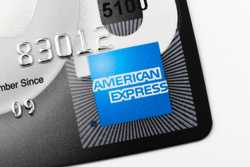- Flat two points per dollar for most spending
- Earns transferable rewards
- No annual fee
Personal Finance
Our evaluations and opinions are not influenced by our advertising relationships, but we may earn a commission from our partners’ links. This content is created by TIME Stamped, under TIME’s direction and produced in accordance with TIME’s editorial guidelines and overseen by TIME’s editorial staff. Learn more about it.
Searching for a solid business credit card to separate your business and personal expenses? If you’re looking to earn travel rewards, give a quick glance at the card_name. It doesn’t usually come with a welcome bonus, but right now you’ll earn 15,000 American Express Membership Rewards® points after spending $3,000 on purchases within the first three months from account opening.
Let’s take a look at how easy it is to earn points with the card_name and explore the best ways to use them.
The Blue Business® Plus Credit Card from American Express
The Blue Business® Plus Credit Card from American Express
TIME’s Take
The card_name delivers an above-average return for most spending. It’s also one of the extremely few no-annual-fee credit cards that allows you to transfer the points you earn to airline and hotel partners for nearly free travel. This is an excellent benefit that puts the card in the mix with the best small-business credit cards with no annual fee.
Pros and cons
Pros:
Cons:
- Rarely offers a welcome bonus
- Annual cap on two points per dollar earning rate
- Only business owners qualify
Who is the card for?
The card_name is a small-business credit card. If you don’t own a business, you won’t qualify. That said, if you’ve got any side gigs—even something as simple as dog-sitting via the Rover app or reselling items on eBay—you could qualify. If you’re making money on the side, you’ve got a small business.
This card is also a great fit for those with spending habits that don’t conform to common bonus categories. The card doesn’t mess with spending bonuses, rotating categories, or any other complicated earning structure. You’re unlikely to find an easier-to-use credit card.
Finally, the card_name is primarily for those who want to travel. The card earns American Express Membership Rewards points, one of the most valuable currencies for (almost) free travel. Unfortunately, it’s not very good at anything else.
Features
Welcome bonus
bonus_miles_full.
Again, this isn’t the norm; credit card applicants typically receive no points upon an account opening, so a bonus is a big deal. It could translate into several hundred dollars toward travel costs if you know how to use it.
Earning rewards
The rewards structure with this card is about as simple as it gets. You earn a flat two points per dollar for all purchases on up to $50,000 in spending per year. After that, you earn just one point per dollar. This is helpful for anyone who doesn’t like to expend mental energy on juggling a variety of bonus categories.
Redeeming rewards
There are a variety of ways to redeem American Express Membership Rewards points, some of which are a bit less than lucrative. Let’s take a quick look at how (and how not) to redeem your points.
Cash equivalents
The worst way to redeem your Amex points is for things such as cash and gift cards. The best value you’ll get is a paltry 1.0 cent per point. Here’s what you can expect when redeeming rewards for cash equivalents.
- Statement credit. You get 0.6 cents per point for each credit.
- Pay with points. You get 0.7 cents per point for paying on Amazon, PayPal, Best Buy, etc..
- Shop with Membership Rewards Points. You get 0.5 cents per point with each participating merchant..
- Gift cards. You get up to 1.0 cent per point for each card.
If you intend to use your rewards in this way regularly, you’ll do far better with a simple cash back credit card.
Amex Travel
You can use American Express Membership Rewards points to offset your order total at checkout within the Amex Travel portal. However, the return you’ll achieve is as grim as opting for gift cards. Here’s the value you’ll get per point.
- You get 1.0 cents per point on airfare.
- You get 0.7 cents per point on prepaid hotels, rental cars, cruises, etc.
Transfer to airline and hotel partners
The hands-down best way to use the rewards you earn from the card_name is to convert them into airline miles and hotel points. Amex partners with 18 airlines and three hotel programs, giving you a wide variety of redemption options.
After earning this card’s welcome bonus, you’ll have 21,000 points (the 15,000-point bonus plus 6,000 points from meeting the card’s minimum spending requirement). Let’s look at a few fun ways to use the rewards you’ll receive.
- Transfer 17,000 points to British Airways for a round-trip coach flight between Miami (MIA) and Grand Cayman (GCM) on American Airlines. This can otherwise cost more than $300, giving you a value per point of 1.7 cents.
- Transfer 20,000 points to Singapore Airlines for a one-way flight between Raleigh (RDU) and Honolulu (HNL) on United Airlines. This can cost over $400, giving you a value of 2.0 cents per point.
- Transfer 20,000 points to Avianca for a one-way flight from Washington, D.C. (IAD) to Dublin (DUB) on United Airlines. This can cost over $600, giving you a value of 3.0 cents per point.
There are many ways to use these points for travel. Again, if you’re not going to redeem your points by transferring them to travel partners, you’ll likely receive a better value from a cash back credit card.
The fine print
The card_name doesn’t charges an annual fee, but you’ll still be subject to the following:
- reg_apr,reg_apr_type.
- A penalty APR of 29.99%.
- balance_transfer_fees.
- late_payment_fee.
- foreign_transaction_fee.
You’ll also pay a 2.7% foreign transaction fee when you make a purchase that is processed outside the U.S.
Additional hidden perks
0% intro APR offer
The card_name comes with a intro_apr_rate,intro_apr_duration (then reg_apr,reg_apr_type). This is a great help if you’ve got a large expense that can’t be paid off within a couple of months, such as an emergency car repair, a medical bill, or a business transaction. It gives you ample time to pay down your balance before you begin accruing interest.
Expanded buying power
While the card does have a set limit, it’s a loose one. You’ll benefit from expanded buying power, which gives you leeway to spend above your limit when necessary. You don’t have to request it; the card will learn your spending habits and weigh factors such as your payment history to determine how far beyond your credit line you’re able to go.
Travel and purchase insurance
The card_name comes with a handful of coverages that complement the needs of businesses, such as:
-
Rental car insurance. You get secondary rental car insurance when you decline the rental agency’s in-house collision damage waiver (CDW). Secondary coverage means that the card will only cover the things that your personal insurance won’t.
- Eligibility and Benefit level varies by Card. Terms, Conditions and Limitations Apply.
- Please visit americanexpress.com/benefitsguide for more details.
- Underwritten by AMEX Assurance Company. Car Rental Loss or Damage Coverage is offered through American Express Travel Related Services Company, Inc.
-
Purchase protection. Eligible items are covered against theft and damage for up to 90 days after the purchase date. You get up to $1,000 per occurrence (a maximum of $50,000 per calendar year).
- Eligibility and Benefit level varies by Card. Terms, Conditions and Limitations Apply.
- Please visit americanexpress.com/benefitsguide for more details.
- Underwritten by AMEX Assurance Company.
-
Extended warranty. Eligible manufacturer’s warranties lasting five years or less will receive up to an additional year of coverage.
- Eligibility and Benefit level varies by Card. Terms, Conditions and Limitations Apply.
- Please visit americanexpress.com/benefitsguide for more details.
- Underwritten by AMEX Assurance Company.
You’ll also get access to a global assist hotline, which is handy when you’re traveling and need help on the go. You can acquire medical referrals, cash wires, missing luggage assistance, and more. Just note that you’ll have to pay for services that you decide to use.
Amex Offers
Amex offers are sort of like digital coupons that you can add to your card_name within your online account. You’ll get curated discounts and bonus rewards for spending with merchants that fit your lifestyle. For example, you may receive an offer that provides a $10 rebate after you spend $30 at a specific restaurant.
Just add an Amex offer to your card and you’ll automatically be rewarded after you complete the offer’s terms. This benefit can save you hundreds of dollars per year with little effort on your part.
What could be improved
The biggest Achilles heel of the card_name is its annual spending cap. You earn two points per dollar for up to $50,000 in spending, then just one point per dollar. Earning one point per dollar is low these days; many cards offer a significantly higher return rate.
For many business owners, particularly sole proprietors, spending $50,000 per year on their business is unlikely. However, if you own a business with large expenses, you may easily exceed $50,000, in which case you’ll likely want to do one of two things.
- Ignore this card and search for a different one that offers a solid return on all spending with no cap.
- Open a second rewards credit card and begin using it after you’ve completed $50,000 in spending with this card.
Also, the fact that the card_name incurs foreign transaction fees is bewildering. The card earns travel rewards, but because of these fees it’s one of the worst cards to use while traveling abroad.
Card alternatives
card_name | card_name | card_name | |
|---|---|---|---|
| Credit score needed | credit_score_needed | credit_score_needed | credit_score_needed |
| Annual fees | annual_fees | annual_fees | annual_fees |
| Bonus rewards | bonus_miles_full | bonus_miles_full | bonus_miles_full |
Bottom line
The ability to earn two Amex points per dollar on all purchases is a valuable perk. It’s not difficult to get more than 2.0 cents per point when redeeming for travel, so you can effectively receive 4% back on all purchases, depending on how you use your rewards.
The Blue Business® Plus Credit Card from American Express
The Blue Business® Plus Credit Card from American Express
Frequently asked questions (FAQs)
What is the card_name credit card?
The card_name is an unsecured business credit card with a simple earning structure to benefit those with spending habits that don’t conform to standard bonus categories.
What credit score do you need for the card_name ?
You should have a credit score rated “good” or better when applying for the card_name . Per FICO, this means a score of 670 or higher.
Is the card_name worth it?
With no annual fee, the card_name is worth a try for just about any small-business owner. It comes with features that you generally only find on an annual fee-incurring credit card, such as the ability to transfer rewards to airline and hotel programs.
Is it hard to get the card_name ?
Not especially. You just need a credit score of 670 or higher. However, if you don’t own a business (even a side hustle), you won’t qualify for the card.
For rates and fees of the The Blue Business® Plus Credit Card from American Express, please visit this URL.
The information related to Costco Anywhere Visa® Card has been collected by TIME Stamped and has not been reviewed or provided by the issuer or provider of this product or service.
The information presented here is created by TIME Stamped and overseen by TIME editorial staff. To learn more, see our About Us page.
Featured Articles

Business Platinum Card from American Express Review 2025
Learn more about the American Express Business Platinum Card, its many benefits, and who it’s right for.

Chase Freedom Unlimited vs. Citi Double Cash Card: Why You'll Earn More with Freedom
Both cards are without an annual fee and feature generous rewards programs. But Freedom Unlimited provides a competitive edge with its cash back welcome bonus.

British Airways Visa Signature® Card Review 2024
The British Airways Visa Signature® card features a lucrative bonus and valuable benefits, but it’s not perfect for everyone. Learn more.

